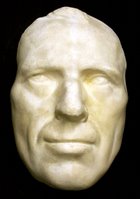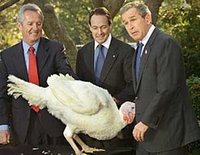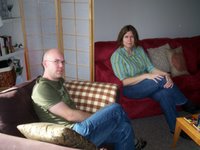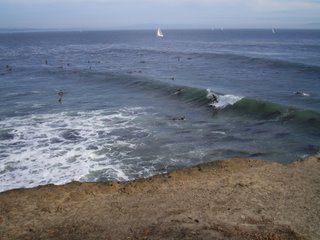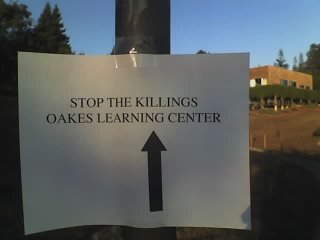I love this list: the things that Fosco discovered in 2006 that gave the year its identity. Of course, many of these things were actually not new in 2006--just new to Fosco. With that in mind, let's tour Fosco's 2006 discoveries...
 Arrested Development: Fosco watched all three seasons on DVD during his recuperation from The Accident. I don't want to exaggerate (or to come across as a pussy), but I think that without this series, I would have been crying most of that first week.
Arrested Development: Fosco watched all three seasons on DVD during his recuperation from The Accident. I don't want to exaggerate (or to come across as a pussy), but I think that without this series, I would have been crying most of that first week.
I've always loved Jason Bateman--ever since as a young queer boy, I crushed hard on him as the lead in the short-lived It's Your Move. I think I even bought a novelization of an episode of that show from the elementery school book club--remember those? But it's not just Bateman that makes AD (as the Kids call it) brilliant: the entire cast is superb and the writing is funnier than anything I've seen on TV, INCLUDING The Simpsons (which is not easy for me to admit...). I mean, this is the show that featured guest appearances from Liza Minelli as a sex-starved widow with vertigo. And then there are the words and phrases that I can't stop repeating to my sister: nevernudes, Bob Loblaw's Law Blog, Motherboy, the dizzies, Anne Paul Veal, "Marry Me."
At this point, there is no question that this is the best television series to air in the first decade of the 21C. There, I said it.- Illinois by Sufjan Stevens: released in 2005, but Fosco didn't start listening to it until the beginning of 2006. It became particularly important to Fosco in November of this year (and, in fact, he is listening to it as he writes this). While Sufjan's Michigan disc was high-quality (and captivated Fosco because of home-state pride), Illinois is truly exceptional. How is it possible to write an achingly beautiful song about the life of John Wayne Gacy? Or a jaunty bluegrass ode to Decatur? Oh, and did I mention that he's hot?
- In-N-Out Burger: the West Coast institution, praised extravagantly by Fosco here.

- Kathy Griffin: I know, I know... This is so cliche: a homosexual who likes Kathy Griffin? Shocking. But, to tell the truth, I never really cared about her until I watched her My Life on the D-List. She's really so appealing and down-to-earth. And she tells such funny stories about Anna Nicole Smith and Gay Gaykin and his Gay-Mates.
- blogs: As 2006 was the year that Fosco launched this little project he likes to call Fosco Lives!, blogs were clearly an important influence on him this year. But which blogs? Almost every morning, Fosco gets his niche news from several outposts of the Nick Denton Empire, including Deadspin, Defamer, and Gawker. And Fosco never travels somewhere without researching Gridskipper for tips on where the cool kids hang out.
More importantly for Fosco and Fosco Lives! however, are two personal blogs: Ted Gideonse's The Gideonse Bible and John Mackey's blog at OstiMusic. These two blogs have served as inspirations for what Fosco Lives! can be and I read them religiously (which is really the only way to read a Bible). Merci, gentleman for a great year of blogging.

- John McPhee on geology: his Pulitzer-Prize-winning Annals of the Former World served as Fosco's guidebook as he drove from Michigan to Santa Cruz along I-80 this summer, stopping along the way to pick up rocks. You can read about Fosco's adventures along the way in the Fosco Lives! Archives here and here.
- "The Nietzsche Family Circus": I have literally spent hours on this website this fall. It cheers me up whenever I'm down. Who would have thought that pairing a random Nietzsche aphorism with a random "Family Circus" cartoon would be the best thing ever? I've permalinked to some of my favorites here, here, and here. Oh God, I'm laughing too hard...

- Matthew Barney's Drawing Restraint 9: Fosco saw this art film three times, despite it running three-ish hours. Do yourself a favor and watch the trailer. Then read Fosco's earlier review.
- Lindsay Lohan and her vulva (SFW). First, I would like to explain why I refuse to participate in the popular convention of referring to pictures like these (NSFW) as pix of Lindsay Lohan's vagina. I may be a homosexual who hasn't touched a woman's vagina in like five years (or so), but I did take Health Class in Junior High and I think what we are looking at is actually Lindsay Lohan's vulva.
Whatever we are looking at, I'm pretty compelled by it. Not the vulva per se, but the idea that a popular teen star would regularly flash her privates to the paparazzi. This plus her drinking problems, her barely literate emails, and her strange belief that she will be aided by Al Gore, make her the most fascinating case of pub(l)ic self-destruction I've seen. Britney (NSFW) is a total amateur compared to Lindsay. The way I see it, Lindsay is one marriage to a homosexual (does she know Clay Aiken?) away from becoming the Judy Garland of this generation. And I can't wait to see what degradation is yet to come!































